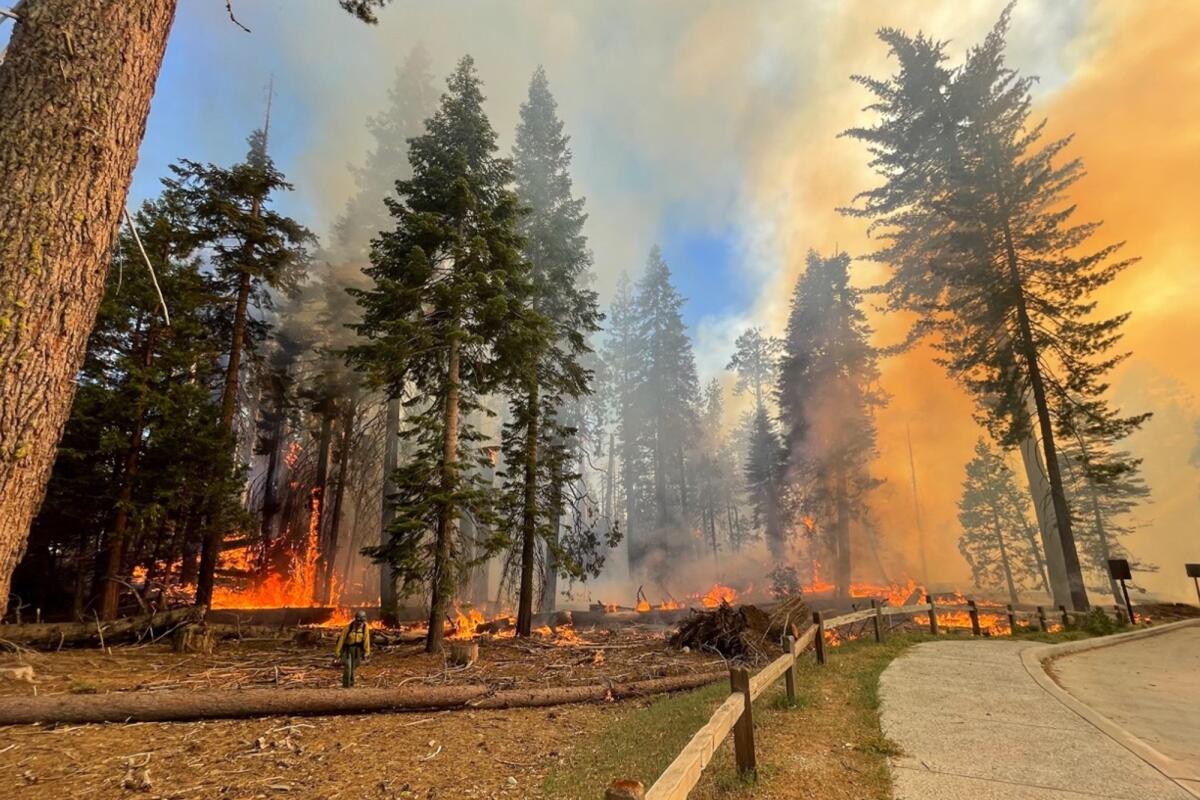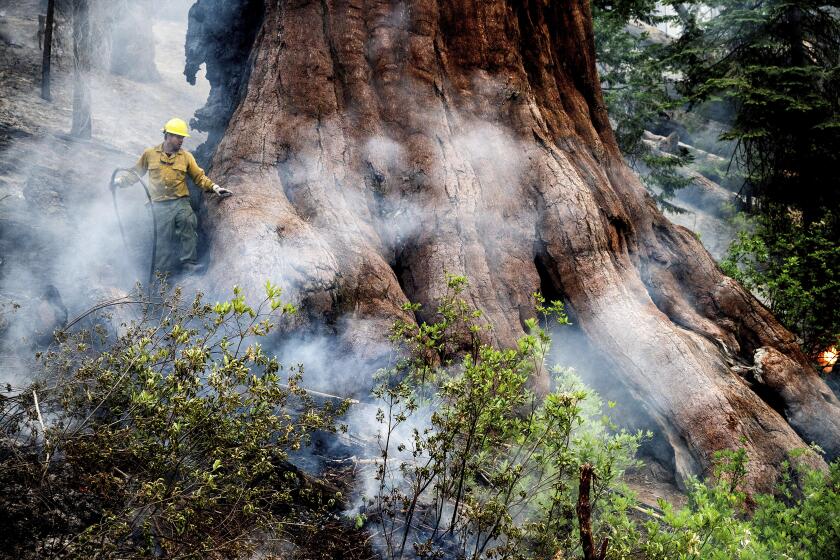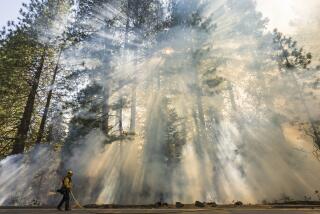Op-Ed: Yosemite’s sequoias survived the latest wildfire. Not all national parks will be so lucky

Watching these past weeks as firefighters battled to stop wildfire from spreading into Yosemite National Park’s famous Mariposa Grove of giant sequoia trees was an urgent reminder of the large-scale threat climate change poses to our national parks.
Unfortunately, fires like the fast-moving Oak fire and the Washburn fire are the new reality for our parks in a warming world. National parks have been consistently understaffed and underfunded by Congress, making it impossible for preventative measures to be taken at an appropriate scale to combat climate emergencies that are now regular occurrences. As of Friday, the Forest Service plans to expedite sequoia protection. When President Biden takes executive action to confront climate change, he should consider increasing funds overall to the national parks before damage happens that can’t be undone.
Before retiring, I spent 34 years working at Yosemite National Park until I was appointed superintendent of Joshua Tree National Park.
Early in my career I spent months in the Mariposa Grove as a log crafter repairing historic structures. It is a truly remarkable place. Later, I helped develop Yosemite’s fire management plan, and I provided logistics support for numerous wildfires, including the Stanislaus complex fire that burned close to 146,000 acres in 1987. Back then, that was considered a large fire.
Throwing every resource at protecting California’s giant sequoias is to deny the climate realities that make the Sierra increasingly vulnerable to wildfire.
Fires have always been a threat at Yosemite, but climate change makes it easier for them to cause much more severe damage. Fires burn hotter and faster, and the landscape is drier and more combustible. Now, fires quickly grow to what was once an unimaginable size. The challenge and threat for park staff, visitors, local businesses and economies is greater than ever, and the costs are immense.
Yosemite is not the only park in the West experiencing the devastating impact of fires exacerbated by climate change. Last year wildfires tore through Kings Canyon and Sequoia national parks, which are also home to sequoia groves. General Sherman — considered the largest tree in the world — was protectively wrapped as park staff feared it may become a high-profile casualty of the fire.
In 2020, the Cima Dome fire torched more than 40,000 acres of the California desert, including a large swath of Mojave National Preserve, killing as many as 1.3 million Joshua trees. That same year, at Rocky Mountain National Park in Colorado, a fire burned almost 200,000 acres and forced the evacuation of more than 35,000 people.
Fires are not the only danger climate change poses to our national parks. Just this summer, extreme weather events wreaked havoc on Yellowstone, where record-breaking floods swept away houses and bridges and caused an emergency evacuation of the entire park. Glacier National Park’s namesake glaciers are quickly receding because of rising temperatures.
As a whole, national parks warmed at double the rate of the United States between 1895 and 2010, leaving parks exceptionally vulnerable. The National Parks Conservation Assn. says climate change is the greatest threat our parks have ever faced.
When it comes to increased risk of fires, steps can be taken to mitigate the problem. Prescribed burns, for example — planned fires overseen by firefighters that reduce forest fuels such as dead leaves — help keep the wildfires we know are coming from spreading out of control. As a bonus, they can also reduce carbon emissions.
Giant sequoias, bristlecone pines and Joshua trees are under threat. Are we doing enough to protect iconic trees that are increasingly vulnerable?
Fighting out-of-control wildfires is far more expensive than preventing them, but for decades agencies such as the National Park Service and Forest Service have been consistently underfunded by Congress. This leaves them without enough staff or bandwidth to do work such as prescribed burns. The giant sequoias in the Mariposa Grove were successfully protected in great part due to this kind of preventive treatment. But only a fraction of the Sierra Nevada area has undergone regimens of this sort, and many other similar areas across the country are also under threat.
Our national parks need Congress to provide the agencies running them with the necessary staff and funds. If Congress won’t act, Biden should. Reducing carbon pollution and investing in preventative treatments are small measures in the large-scale efforts to combat climate change. But they can give park staff and fire crews a better shot at containing out-of-control wildfires and protecting some of our country’s most-loved outdoor places.
Mark Butler is the former superintendent of Joshua Tree National Park and was chief of project management at Yosemite National Park.
More to Read
A cure for the common opinion
Get thought-provoking perspectives with our weekly newsletter.
You may occasionally receive promotional content from the Los Angeles Times.











